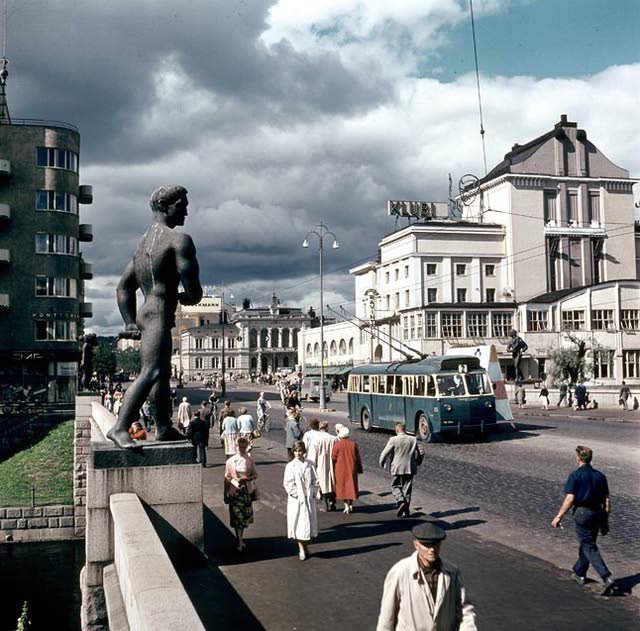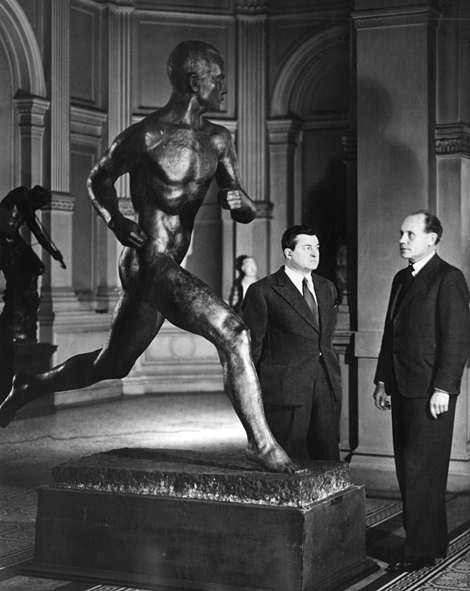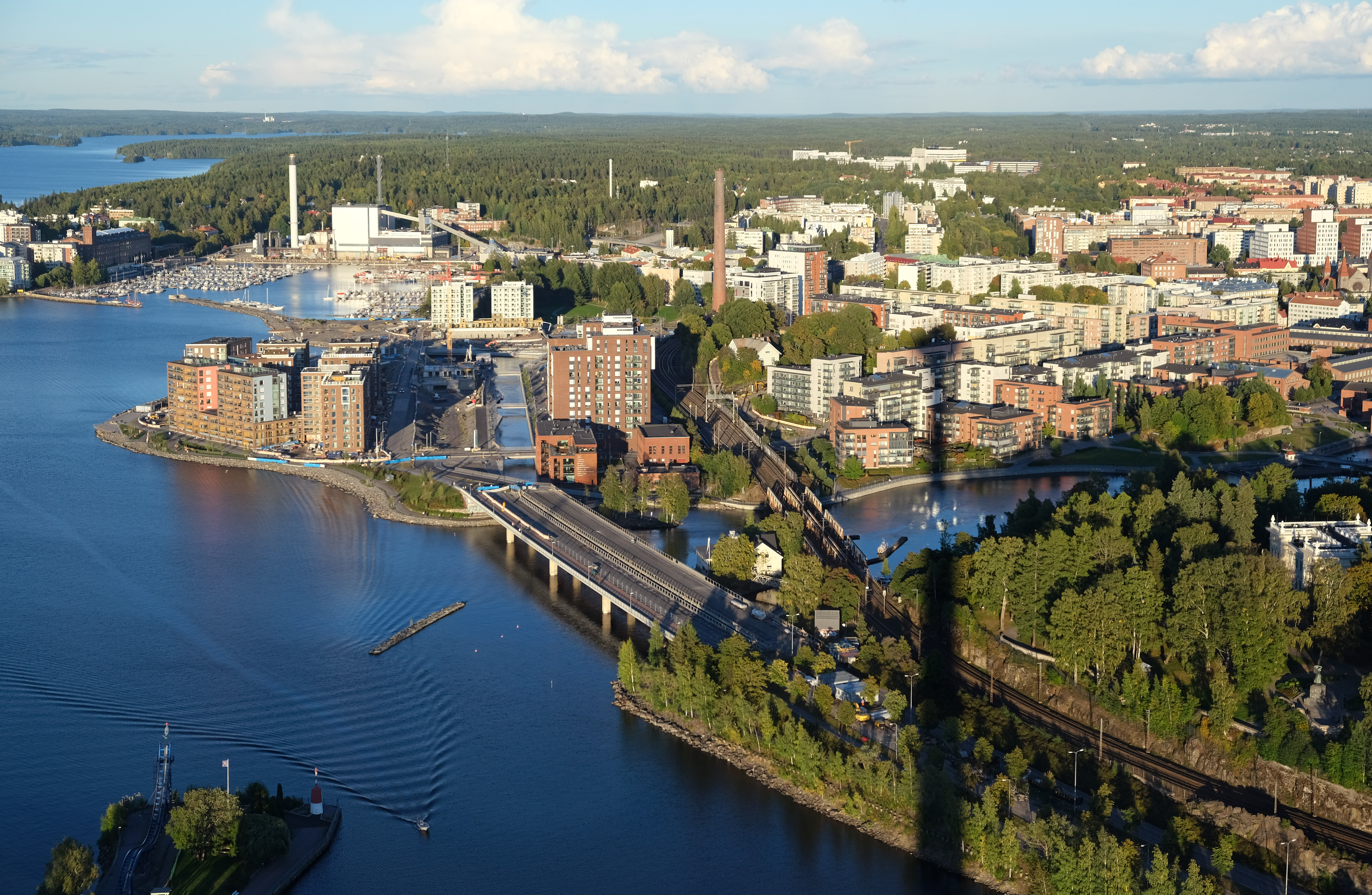|
Hämeensilta
Hämeensilta (the ″Häme Bridge″) is a bridge in Tampere, Finland, crossing the Tammerkoski rapids. The main street of Tampere, Hämeenkatu, runs along the bridge, connecting the Kyttälä district to the western parts of the city center. Hämeensilta is one of the city's best known landmarks, especially famous for the statues on the rails of the bridge. The arches of the bridge are made of concrete and they are coated with a red granite. The Hämeensilta was completed in 1929. It is named after the Finnish name of the Tavastia province. History The first known bridge crossing the Tammerkoski was built in the 16th century as the area was a part of the Messukylä socken. As the town of Tampere was established in 1779, the wooden bridge was finally replaced with a steel structured in 1884. During the early 1900s, Tampere was rapidly growing and the present Hämeensilta was built in 1928–1929. The 1900 completed Satakunnansilta is the other large bridge crossing Tammerkosk ... [...More Info...] [...Related Items...] OR: [Wikipedia] [Google] [Baidu] |
Hämeenkatu
Hämeenkatu is the main street of Tampere, Finland, located in the city center. The boulevard is roughly a kilometre long, and wide (driveway and sidewalk) at its widest point. Hämeenkatu is a boulevard, which begins from the east at the Tampere railway station, continues westward to the Hämeenpuisto park, and is covered with cobble stones for its entire length. The street also contains the Hämeensilta bridge crossing the Tammerkoski rapids with gorgeous views on both sides. The bridge that Hämeenkatu runs across Tammerkoski is decorated with four human statues, one at each corner of the bridge. Of these statues, three represent men and one represents a woman. Eastwards from the railway station, Hämeenkatu is followed by the -long Itsenäisyydenkatu, which then diverges into Sammonkatu and Teiskontie. In the west, Hämeenkatu continues first as Pirkankatu and then as Pispalan valtatie. Construction of the Tampere light rail on the street started in 2017, and in connect ... [...More Info...] [...Related Items...] OR: [Wikipedia] [Google] [Baidu] |
Tampere
Tampere ( , , ; sv, Tammerfors, ) is a city in the Pirkanmaa region, located in the western part of Finland. Tampere is the most populous inland city in the Nordic countries. It has a population of 244,029; the urban area has a population of 341,696; and the metropolitan area, also known as the Tampere sub-region, has a population of 393,941 in an area of . Tampere is the second-largest urban area and third most-populous individual municipality in Finland, after the cities of Helsinki and Espoo, and the most populous Finnish city outside the Greater Helsinki area. Today, Tampere is one of the major urban, economic, and cultural hubs in the whole inland region. Tampere and its environs belong to the historical province of Satakunta. The area belonged to the Häme Province from 1831 to 1997, and over time it has often been considered to belong to Tavastia as a province. For example, in '' Uusi tietosanakirja'' published in the 1960s, the Tampere sub-region is presented as p ... [...More Info...] [...Related Items...] OR: [Wikipedia] [Google] [Baidu] |
Satakunnansilta
Satakunnansilta (the ″Satakunta Bridge″) is an old bridge in Tampere, Finland, that crosses the Tammerkoski rapids north of Hämeensilta. The bridge is part of the Satakunnankatu street and is used by both vehicle traffic and pedestrians. The Satakunta Bridge was designed by engineer Karl Snellman, son of Senator J. V. Snellman. It was built between 1897 and 1900 and commissioned on October 9, 1900. The bridge is a 6-span stone arch bridge An arch bridge is a bridge with abutments at each end shaped as a curved arch. Arch bridges work by transferring the weight of the bridge and its loads partially into a horizontal thrust restrained by the abutments at either side. A viaduct ... with spans of 17 meters. The width of the bridge is 11.75 meters and its total length is 112.6 meters. In 2013, the bridge railings were refurbished to the original model, and in 2014, the bridge lamps were replaced with the original model. References External links Satakunnansilt ... [...More Info...] [...Related Items...] OR: [Wikipedia] [Google] [Baidu] |
Wäinö Aaltonen
Wäinö Valdemar Aaltonen (8 March 1894 – 30 May 1966) was a Finnish artist and sculptor. The Chambers Biographical Dictionary describes him as "one of the leading Finnish sculptors". He was born to a tailor in the village of Karinainen, Finland. He became interested in art after being deaf as a child, and attended the School of Drawing of the Turku Art Association from age 16, or specifically between 1910 and 1915. He had spent many of the early years at this school studying painting, but he was mainly self-taught as a sculptor. He learned the technics of treatment of marble with his relative Aarre Aaltonen, and by working as a trainee stonemason in Hirvensalo. Sculptor Felix Nylund was a substitute teacher in the art school in Turku for one season, and his work was inspiration for young Aaltonen. A journey Aaltonen made to Italy in 1923 opened his eyes to cubist and futurist art. These elements can primarily be seen in his paintings. As the Republic of Finland arose, and t ... [...More Info...] [...Related Items...] OR: [Wikipedia] [Google] [Baidu] |
Tammerkoski
Tammerkoski is a channel of rapids in Tampere, Finland. The city of Tampere is located between two lakes, Näsijärvi and Pyhäjärvi. The difference in altitude between these two is and the water flows from Näsijärvi to Pyhäjärvi through the Tammerkoski rapids. The banks of the Tammerkoski are among the oldest industrial areas in Finland. There was a busy marketplace in the 17th century. Tampere was founded on the banks of the rapids, as the rushing water provided a great deal of power for the needs of industry. There are four power stations and three dams located on the Tammerkoski. The highest in altitude is the dam between Finlayson and Tampella. From this dam, the stream is led to the power stations of Finlayson and Tampella on either side of the rapids. In the middle, there is the city's power plant and the lowest one in terms of altitude is the dam at the Tako paperboard mill, which belongs to M-real. The three uppermost power stations are owned by the city, whil ... [...More Info...] [...Related Items...] OR: [Wikipedia] [Google] [Baidu] |
Buildings And Structures In Tampere
A building, or edifice, is an enclosed structure with a roof and walls standing more or less permanently in one place, such as a house or factory (although there's also portable buildings). Buildings come in a variety of sizes, shapes, and functions, and have been adapted throughout history for a wide number of factors, from building materials available, to weather conditions, land prices, ground conditions, specific uses, prestige, and aesthetic reasons. To better understand the term ''building'' compare the list of nonbuilding structures. Buildings serve several societal needs – primarily as shelter from weather, security, living space, privacy, to store belongings, and to comfortably live and work. A building as a shelter represents a physical division of the human habitat (a place of comfort and safety) and the ''outside'' (a place that at times may be harsh and harmful). Ever since the first cave paintings, buildings have also become objects or canvasses of much arti ... [...More Info...] [...Related Items...] OR: [Wikipedia] [Google] [Baidu] |
Bridges In Finland
A bridge is a structure built to span a physical obstacle (such as a body of water, valley, road, or rail) without blocking the way underneath. It is constructed for the purpose of providing passage over the obstacle, which is usually something that is otherwise difficult or impossible to cross. There are many different designs of bridges, each serving a particular purpose and applicable to different situations. Designs of bridges vary depending on factors such as the function of the bridge, the nature of the terrain where the bridge is constructed and anchored, and the material used to make it, and the funds available to build it. The earliest bridges were likely made with fallen trees and stepping stones. The Neolithic people built boardwalk bridges across marshland. The Arkadiko Bridge (dating from the 13th century BC, in the Peloponnese) is one of the oldest arch bridges still in existence and use. Etymology The ''Oxford English Dictionary'' traces the origin of the w ... [...More Info...] [...Related Items...] OR: [Wikipedia] [Google] [Baidu] |
Bridges Completed In 1929
A bridge is a structure built to span a physical obstacle (such as a body of water, valley, road, or rail) without blocking the way underneath. It is constructed for the purpose of providing passage over the obstacle, which is usually something that is otherwise difficult or impossible to cross. There are many different designs of bridges, each serving a particular purpose and applicable to different situations. Designs of bridges vary depending on factors such as the function of the bridge, the nature of the terrain where the bridge is constructed and anchored, and the material used to make it, and the funds available to build it. The earliest bridges were likely made with fallen trees and stepping stones. The Neolithic people built boardwalk bridges across marshland. The Arkadiko Bridge (dating from the 13th century BC, in the Peloponnese) is one of the oldest arch bridges still in existence and use. Etymology The ''Oxford English Dictionary'' traces the origin of the ... [...More Info...] [...Related Items...] OR: [Wikipedia] [Google] [Baidu] |
Erkkilän Silta
Erkkilän silta (the ″Erkkilä Bridge″) is a bridge located in the center of Tampere, Finland. It crosses the railway yard to the north of the Tampere Central Station, connecting the Jussinkylä and Tammela districts. The bridge is a type of steel tied-arch bridge, a combination of arch and beam bridge with a span of 42 meters. The stone ground supports of the bridge come from a bridge built in 1963 on the same site. The bridge was completed in 1983.6.9.2005 - Ulkomaille Teiskoon - Kulkkila (in Finnish) In connection with the construction of the bridge, another old ground support was reinforced with drill piles. The bridge was renovated in 2005 by, among other things, renewing the waterproofing
[...More Info...] [...Related Items...] OR: [Wikipedia] [Google] [Baidu] |
New York City
New York, often called New York City or NYC, is the most populous city in the United States. With a 2020 population of 8,804,190 distributed over , New York City is also the most densely populated major city in the United States, and is more than twice as populous as second-place Los Angeles. New York City lies at the southern tip of New York State, and constitutes the geographical and demographic center of both the Northeast megalopolis and the New York metropolitan area, the largest metropolitan area in the world by urban landmass. With over 20.1 million people in its metropolitan statistical area and 23.5 million in its combined statistical area as of 2020, New York is one of the world's most populous megacities, and over 58 million people live within of the city. New York City is a global cultural, financial, entertainment, and media center with a significant influence on commerce, health care and life sciences, research, technology, education, ... [...More Info...] [...Related Items...] OR: [Wikipedia] [Google] [Baidu] |
1939 New York World's Fair
The 1939–40 New York World's Fair was a world's fair held at Flushing Meadows–Corona Park in Queens, New York, United States. It was the second-most expensive American world's fair of all time, exceeded only by St. Louis's Louisiana Purchase Exposition of 1904. Many countries around the world participated in it, and over 44 million people attended its exhibits in two seasons. It was the first exposition to be based on the future, with an opening slogan of "Dawn of a New Day", and it allowed all visitors to take a look at "the world of tomorrow". When World War II began four months into the 1939 World's Fair, many exhibits were affected, especially those on display in the pavilions of countries under Axis occupation. After the close of the fair in 1940, many exhibits were demolished or removed, though some buildings were retained for the 1964–1965 New York World's Fair, held at the same site. Planning In 1935, at the height of the Great Depression, a group of Ne ... [...More Info...] [...Related Items...] OR: [Wikipedia] [Google] [Baidu] |
Birkarls
The Birkarls (''birkarlar'' in Swedish, unhistorical ''pirkkamiehet'' or ''pirkkalaiset'' in Finnish; ''bircharlaboa'', ''bergcharl'' etc. in historical sources) were a small, unofficially organized group that controlled taxation and commerce in central Lappmarken in Sweden from the 13th to the 17th century.Vahtola, Jouko. ''Tornionlaakson historia I''. Birkarlit, 'pirkkalaiset'. Malungs boktryckeri AB. Malung, Sweden. 1991. The article draws heavily from the material available in the book. Background Birkarls (bircharlaboa) are first mentioned in 1328, when they are listed as one of the settler groups in northern Hälsingland, a designation that covered the western coast of Gulf of Bothnia all the way up and around the gulf to Oulu River. The name ''birkarl'' probably originates from an ancient Scandinavian word '' birk'' that has been used in reference to commerce in various contexts. In the late 16th century, claims about birkarls coming from Great Pirkkala (a parish in U ... [...More Info...] [...Related Items...] OR: [Wikipedia] [Google] [Baidu] |






.jpg)